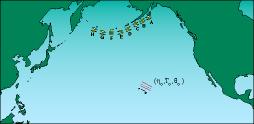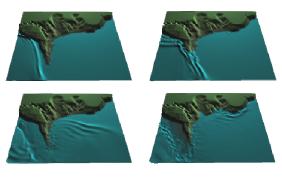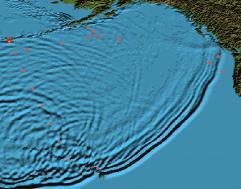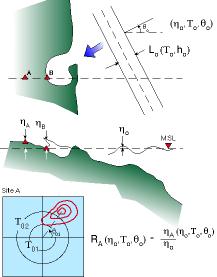Pacific Disaster Center (PDC) &
Maui High Performance Computing Center (MHPCC)
Tsunami Modeling
| Tsunami Forecasting and Hazard Assessment Capabilities Vasily Titov, Frank Gonzalez and Hal Mofjeld |
||||
| A suite of numerical simulation codes, known collectively as the MOST (Method of Splitting Tsunami) model, have been implemented and tested on the Maui High Performance Computing Center (MHPCC) IBM PS2 nodes. Together, they are capable of simulating the three primary processes of tsunami evolution, i.e., generation by an earthquake, transoceanic propagation, and inundation of dry land. Generation and propagation capabilities were tested against deep ocean bottom pressure recorder collected by PMEL during the 1996 Andreanov tsunami; inundation computations were compared with field measurements of maximum runup on Okushiri Island collected shortly after the 1993 Hokkaido-Nansei-Oki tsunami. | Research objective The goal of this work is to provide forecasting and hazard assesment guidance for Hawaii during an actual tsunami event. | |||
| Methodology Supercomputer implementation of the MOST model allows the efficient computation of many scenarios. This capability is used to perform multiple-run sensitivity studies of two closely related, but separable, processes -- offshore wave dependence on distant earthquake magnitude and position, and site-specific inundation dependence on offshore wave characteristics. The results will be organized into an electronic database, and associated software will be developed for analysis and visualization of this database, including the assimilation of real-time data streams. | ||||
| Results The MOST model has been successfully parallelized and implemented on the MHPCC IBM PS2 supercomputer. Field observations acquired during the Pacific-wide 1996 Andreanov tsunami have been used to test the generation and propagation capabilities of the code, and the inundation capabilities of the code have been tested against runup data acquired on Okushiri Island after the 1993 Hokkaido-Nansei-Oki earthquake and tsunami. | ||||
| Significance The current state-of-the-art in tsunami modeling still requires considerable quality control, judgment, and iterative, exploratory computations before a scenario is assumed reliable. This is why the efficient computation of many scenarios for the creation of a database of pre-computed scenarios that have been carefully analyzed and interpreted by a knowledgeable and experience tsunami modeler is an essential first step in the development of a reliable and robust tsunami forecasting and hazard assessment capability. As currently implemented, the computation of 6.5 hours of tsunami propagation takes about 1 hour; as the model utilizes more efficient parallelization algorithm, the computing/real time ratio will drop dramatically. Using more advanced parallel algorithm, it may become technically feasible to execute real-time model runs for guidance as an actual event unfolds. However, this is not currently justified on scientific grounds; an operational real-time model forecasting capability must await improved and more detailed characterization of earthquakes in real-time, and verification that the real-time tsunami model computations are sufficiently robust to be used in an operational, real-time mode. |
 Figure 1. Linear propagation. Figure 2. Nonlinear runup. | |||
 Figure 4. Okushiri simulation. |
 Figure 3. Andreanov simulation. | |||
